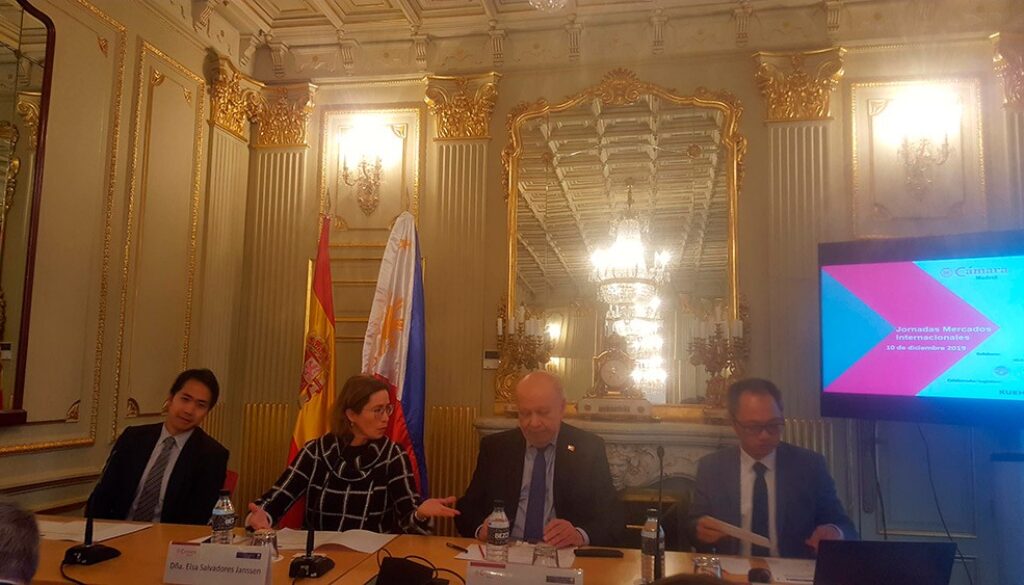How to do business with the Philippines. Gil Stauffer gives you an overview from the Madrid Chamber of Commerce.
DOING BUSINESS WITH THE PHILIPPINES. GIL STAUFFER GIVES YOU AN OVERVIEW BY THE CHAMBER OF MADRID
How to do business with the Philippines? Join us on our tour
16/12/2019
In an overview of the most salient aspects of the economy and society of the PhilippinesWe attended the conference held at the Camera from Madrid on 10 December. The opening was given by Elsa Salvadores Janssen, que realizó una breve introducción sobre este mercado internacional y ejerció la moderación del encuentro.
They intervened afterwards, Philippe Jones Lhuillier, Philippine Ambassador to Spainwho gave a short speech of welcome. Later, he spoke Mikhal of God, Commercial Attaché and Vice-Consul of the Embassy of the Philippines in SpainThe Minister, who spoke about the business climate in that market and the relations between the Philippines and Spain. Finally, the Mr Pamintuan, Economic and Trade Counsellor of the Philippinesgave a presentation entitled "Business and Investment Opportunities in the Philippines".
The following is therefore an extract of the highlights of the meeting:
GEOGRAPHICAL AND SOCIAL ISSUES:
The Philippines is a country located in the Western Pacific Ocean in South Asia and is made up of the following countries more than seven thousand islands. The archipelago totals 300,000 kilometres and is about 800 kilometres from the Asian mainland. Its capital, located on the island of Luzon, is Manilaa large, densely populated coastal city.
With more than 100 million inhabitants, its average age is only 24, which seems to project a promising future. Moreover, its official language is English and this makes it much easier to relations with foreign companies.
ECONOMIC ASPECTS:
The Philippines is one of the most important players in the Asian economy. has recorded spectacular data over the last decade, with an average annual growth rate of over 5.7%. It is one of the fastest growing economies in Southeast Asia, with projections that it will be the world's 16th largest economy by 2050. The country is currently in the midst of a major infrastructure plan 150 billion euros will be invested by 2022 and aims to reach 7% of GDP in public investment. Specifically, this infrastructure plan aims to improve road connections, as well as other types of transport. Consumption and investment stand out as the main stimuli that will promote the island nation's economic expansion, both this year and next, and the government has placed special emphasis on renewable energies, tourism and finance as the preferred sectors.
Philippines and Spain have close relations that go back centuries and are now expected to be further strengthened. It is a country that is shaping up as an interesting gateway to the Asian marketWith a population of 650 million, this is a very interesting business niche.
On trade, the bilateral relationship continues to strengthen. The sum of exports and imports 758 million in 2018, marking a new record of historical record. Exports in the last five years have grown at an average rate of 9.9%. Alongside traditional products, an image of Spain as a country with competitive technology is increasingly taking hold.
Given the high level of youth populationThe Philippines is a country where the technology is intensely present and where the process modernisation and systems is notorious. Thus, terms such as e-commerce, blockchainetc. are very easy to process in the Philippine business world.
LEGAL FRAMEWORK: DEFINITION AND GENERAL RULES:
The Foreign Investment Act 1991 is the basic law governing foreign investment in the Philippines.
This legal framework involved the liberalisation of the entry of foreign investment in the country up to 100% of property, unless there are restrictions by the constitution or other special laws enumerated in the Foreign Investment Negative List. It seeks to promote foreign investments and prescribe the procedures for registering the company to do business in the Philippines, but protecting its SME industries (existing and proposed operations) in the country.
There is therefore a list of sectors where foreign entry is prohibited or restricted. This list is renewed every two years and has two sections:
The list Awhich vetoes or limits access to the following sectors, leaving it to Filipino nationals:
- The media.
- Retail trade with capital of less than US$2.5.
- Private security.
- The use of marine resources.
- Chemical, biological, radiological, radiological, nuclear and weapons products.
- Professional certifications.
- Cooperatives.
- Small-scale mining.
- Pyrotechnics.
- Booths
For its part, the List B limited for reasons of security, defence, risk to health or morals, and the protection of small and medium-sized enterprises.
This means that, in order to invest in the sectors indicated, it is necessary to make partnerships with philippine companies in which they have a majority stake (joint-ventures).
USEFUL ADDRESSES:
- Chamber of Commerce and Industry of Madrid
- Philippine Board of InvestmentsThe Department of Trade and Industry of the Republic of the Philippines, an agency attached to the Department of Trade and Industry in the Republic of the Philippines.
- Department of Tourism - Republic of the Philippines
- Philippine Retirement Authority, a government-controlled corporation attached to the Philippine Department of Tourism (DOT) with a mandate to attract foreign nationals and former Filipino nationals to invest, reside and retire in the Philippines in order to accelerate social development.
- Bureau of Immigration
- Philippine Trade and Investment Center (PTIC)-Paris The Philippine Trade and Investment Centre (PTIC)-Paris is the attached trade section of the Philippine Embassy in Paris, and is the representative office of the Department of Trade and Industry (DTI) in France. Its mission is to promote Philippine exports and services, generate inward investments and provide assistance in bilateral and multilateral trade and economic negotiations. Their areas of expertiseThe areas of coverage are France, Italy, Portugal, Spain and Turkey.
- Embassy of the Philippines in Madrid
And if you decide to do business with the Philippines and needs support for Mobility Services (national or international removals, relocation services(e.g., custody or management of archives, storage, etc.) is provided with GIL STAUFFER. We have been specialists since 1905.







